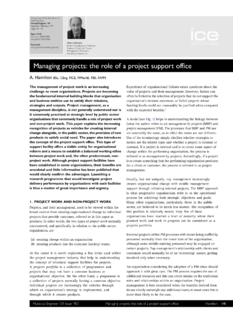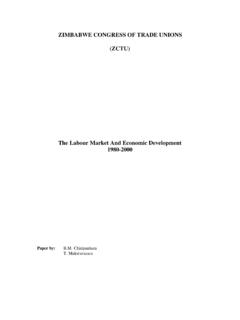Transcription of CHAPTER 2 THE AUTOMOBILE INDUSTRY IN AND …
1 1 CHAPTER 2 THE AUTOMOBILE INDUSTRY IN AND BEYOND THE CRISIS Introduction and summary The AUTOMOBILE INDUSTRY has been severely hit by the crisis The AUTOMOBILE INDUSTRY is among the sectors that have been hit most by the recession. Demand for cars fell sharply, accentuating the difficulties of excess production capacity already faced before the crisis and deepening the economic downturn in major car-producing countries. Relative to the general downturn, the decline in car sales was nonetheless not deeper than what was observed in the past. The AUTOMOBILE This CHAPTER considers the role of the AUTOMOBILE INDUSTRY in the current cycle. It first examines the role of the INDUSTRY in the economy, before analysing the relation between the AUTOMOBILE and business cycles. After casting some light on the sources of the collapse in car sales at the start of the crisis, the CHAPTER discusses the policy measures, in particular car scrapping programmes, put in place to support the AUTOMOBILE INDUSTRY .
2 Finally it investigates the short and medium-term prospects for the AUTOMOBILE INDUSTRY . The main results are the following: ..is economically The size of the AUTOMOBILE INDUSTRY relative to overall activity is small, but because of its strong linkages with other parts of the economy, the final impact of a shock in the INDUSTRY on the broader economy is sizable.. and intertwined with business cycles The AUTOMOBILE and business cycles usually move in line with each other but the amplitude of the cycle is higher in the AUTOMOBILE INDUSTRY . The volatility of the AUTOMOBILE INDUSTRY is also higher than that of the manufacturing industries as a whole. It has suffered from constrained credit in the Evidence for the United States and Canada suggests that the reduction in car sales since mid-2008 has been magnified by the lack of access to credit, leading many households to postpone their car purchases.
3 This implies that continued improvement in financial market conditions could provide an impetus to car sales. 2 .. but benefited from government Government support to the AUTOMOBILE INDUSTRY has been provided in a variety of forms, including subsidies to firms and direct involvement in INDUSTRY restructuring plans. These measures are likely to impede the structural changes the INDUSTRY will need to go through in the years to come.. including car scrapping Many countries have introduced car scrapping schemes to cushion the overall downturn in economic activity, boosting sales in the short term. However, crowding-out effects whereby the demand for new cars dampens the demand for other products are likely to have lowered their final impact on economic activity. As these programmes are temporary and consist mostly in a shift of purchases from the future to the present, the surge in sales is likely to be reversed after the schemes end.
4 Evidence on the timing and the magnitude of this payback effect varies but suggests that over the short term, car sales may be temporarily depressed by the termination of scrapping programmes in many countries. At the same time, these schemes do not appear to be cost-effective instruments to reduce greenhouse gas emissions.. and is set to rebound in many As actual sales are well below trend, a rebound in car sales is likely in North America, Japan and the United Kingdom. In contrast, car sales in Germany have been pushed significantly above trend and may weaken going forward.. though medium-term sales trends are likely to be divergent across regions Over the medium term, regions within and outside the OECD are likely to experience diverse trends in car sales. In mature markets, such as Europe and North America, trend sales are likely to remain stagnant.
5 By contrast, rapid increases are foreseen in China, which is already now the second largest market for cars. A rapid increase is also projected in India. Medium-term projections suggest that capacity exceeds trend sales by around 20% in the five largest Western European markets considered as a whole. Without an adjustment in capacity, these countries would need to ensure an ongoing strong export performance. By contrast, in North America, capacity is projected to be around 65% of trend sales. Automakers in the NAFTA area would thus need to halt their decline in domestic market share or to rely increasingly on exports in order to avoid excess capacity. The fortunes of Korean and Japanese auto firms are heavily tied to world markets as they export a large part of their production. Maintaining their high levels of capacity utilisation will require them to keep up their strong export performance.
6 3 The importance of the AUTOMOBILE INDUSTRY in the economy The INDUSTRY is more important than its size implies The AUTOMOBILE industry1 represents a relatively small share of the overall size of OECD economies in terms of value added and employment (Figure ). But this hides large variation across countries. The AUTOMOBILE Figure Value added, employment, exports by sector in OECD economies, 2006 1. All countries except Australia, Canada, Ireland, Mexico, New Zealand, Turkey. 2. All countries except Australia, Denmark, United Kingdom, Iceland, Luxembourg, Mexico, New Zealand, Poland, Turkey. 3. All countries except Mexico, Slovak Republic and Turkey. Source: OECD STAN Database; OECD Economic Outlook 86 database. 1 . For the purposes of this CHAPTER the AUTOMOBILE INDUSTRY includes companies that are involved in production of cars, including their design, testing, manufacturing and sales.
7 In the United States it includes companies producing light vehicles as this series contains vehicles such as SUVs (4x4s) that are defined as cars elsewhere. Definitions vary depending on the series used. 4 INDUSTRY accounts for almost 4% of total output in the Czech Republic and Germany, while it is almost non-existent in several countries (Figure ). Over 2% of employed people work in the INDUSTRY in the large AUTOMOBILE -producing countries. These numbers understate the size of the AUTOMOBILE -related workforce, as a higher number of people are employed in the AUTOMOBILE value chain both downstream, in services such as car financing, insurance and maintenance, and upstream, in steel and In many car-producing countries a large share of output is exported. AUTOMOBILE exports represent more than 20% of manufacturing exports in Japan, the Slovak Republic, Hungary, Canada and Spain, and account for more than or close to 15% of total exports in these countries.
8 The current structure of the INDUSTRY is the result of a long process of structural change (Box ), which is likely to have further to go (see below). Box Some specific features of the AUTOMOBILE INDUSTRY The INDUSTRY is capital intensive, with a relatively high capital-to-labour ratio, and in many countries a large share of the production is exported. In recent years, production has been increasingly shifted towards non-OECD regions, in particular Asia. Between 2000 and 2007, the share of the United States and Japan in global production fell from 40 to 30%, while the share of the non-OECD areas increased from producing of one car in ten to one car in five (OECD, 2009). The economic crisis may serve to reinforce and accelerate this trend. Market saturation in OECD countries, high shipping costs and efforts by automakers to gain market share by locating production where they sell have encouraged these trends.
9 Outsourcing the manufacturing of small automobiles and parts has also been increasing among main car producers. At the same time, the minimum efficient scale of production has increased over time, spurring mergers and acquisitions in order to gain economies of scale. The resulting economic geography of the INDUSTRY is complex, with only some segments being fully global (Sturgeon and Van Biesebroeck, 2009). Automakers and part suppliers form buyer-supplier relationships on a global scale. Inter-regional vehicle and parts trade is substantial, but capped by political and operational considerations. Intra-regional trade of finished vehicle and parts is the dominant operational pattern. Domestic production is still very strong in many national markets. Activities such as design or assembly tend to be geographically concentrated in clusters of specialised activity within countries.
10 The INDUSTRY has been in a difficult situation for some years, especially the three big American producers which have traditionally been specialised in larger vehicles. The rise in oil prices up to mid-2008 drove material costs higher and also shifted consumer preferences towards smaller vehicles. High debt burdens, huge fixed capital and labour costs, as well as sizable pension and health care commitments to retirees added to their difficulties. Finally, strong vehicle sales in the previous decade, fuelled by discounts, created saturated markets, especially in the United States. 2 . Input-output tables allow the quantification of the size of multiplier effects from the AUTOMOBILE INDUSTRY to the rest of the economy. These multipliers combine information on both domestic and import inter-sectoral linkages.

















